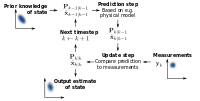
Photo from wikipedia
Abstract Recently, the application of rank minimization to image denoising has shown remarkable denoising results. However, due to iterative nature of low rank optimization, the estimation of noise for next… Click to show full abstract
Abstract Recently, the application of rank minimization to image denoising has shown remarkable denoising results. However, due to iterative nature of low rank optimization, the estimation of noise for next iteration is an essential requirement after each iteration. In the existing approaches, the noise is estimated at the level of patches using l2 norm based comparison of the observed image and its denoised version. Because of l2 norm comparison, these patch-wise noise estimates may be affected in the presence of moderate and severe levels of noise. Also, the patch-wise noise estimates are inferred without considering the geometric details of a given image. Moreover, the number of iterations is pre-specified, heuristically, depending on the known initial noise in the image which limits the applicability of the existing algorithms for practical situation where the noise level is not a priori. In this paper, we attempt to address these limitations by introducing the notion of residual noise for iterative rank minimization. The estimation of residual noise also involves image geometry and statistical characteristics along with patch-wise comparison. In addition to more reliable noise estimation, the residual noise can also be employed as an effective stopping criterion for iterative denoising process. Furthermore, the residual noise estimation is a key factor for computation of thresholding weights, which in turn, yield a more reliable truncated singular value decomposition (SVD) for iterative rank minimization algorithms. Based on more precise truncated SVD, we propose to preserve geometric features like edges and texture in the presence of severe noise. Experimental results show that the proposed method provides better or equivalent results as compared to various state-of-the-art denoising algorithms.
Journal Title: Neurocomputing
Year Published: 2018
Link to full text (if available)
Share on Social Media: Sign Up to like & get
recommendations!